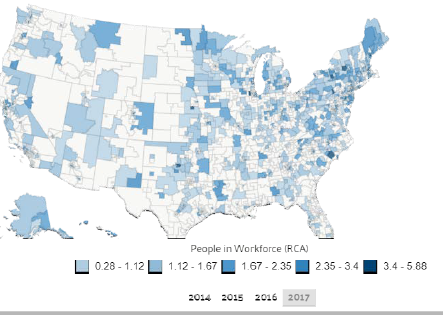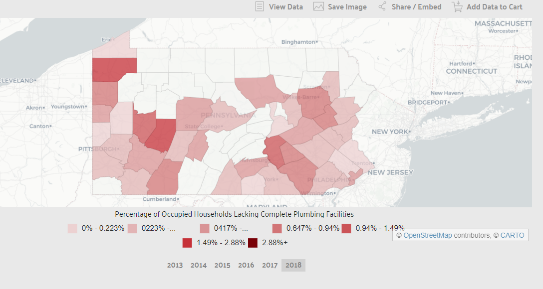Positive Approaches Journal, Volume 9, Issue 3
Wong | 67-75

Volume 9 ► Issue 3 ► 2020
Social Work Values in Action: Using Data to Meet People Where They Are
Mi-Yeet Wong, LCSW
Introduction
As a social worker, you may have come across people who are unsure or have misconceptions about what you do. In part, this may be because of the misperception of social workers in the media1. To be clear, we do not snatch babies and tear families apart. We do, however, use our social work values to guide our support of individuals, families and communities in a myriad of settings, systems, and roles within which we function. With the reality that we are contending with limited resources and time, and that many of our clients may need support across the lifespan, the use of data to inform planning and to allocate supports is becoming increasingly important. This article will provide information on the guiding principles of social work, the social work workforce and highlight examples of ways that data has been used to meet people where they are.
What Social Workers Do
Social work practice is “the professional application of social work values, principles, and techniques to one or more of the following ends: Helping people obtain tangible services; counseling and psychotherapy with individuals, families, and groups; helping communities or groups provide or improve social and health services; and participating in legislative processes.”2 Social workers are guided by a core set of values, principles, and ethics. These core values include service, social justice, dignity and worth of the person, importance of human relationships, integrity, and competence.3
Social Work Workforce
Since social workers practice in a variety of settings, such as mental health clinics, hospitals, child welfare systems, managed care organizations, private practices, and more, it is no wonder that the social work profession is projected to grow 13% from 2019 to 2029. In comparison, the average growth rate for all occupations is 4%.4 Pennsylvania has one of the highest population of social workers nationally.5 You can look at data from the map below to gain a better understanding of the concentration (or lack of) social workers by county or state5.
Spatial Concentration Map

Exploring the demographics of social workers can also paint a picture of the racial and gender makeup between social workers and the populations they serve. Because social workers practice with different types of populations (child and family social workers, school social workers, healthcare social workers, and more), gaining a better understanding of the workforce capacity helps to identify areas where there is a shortage of social workers relative to needs. In addition to using data to better understand workforce capacity, social work practice transcends various systems, ultimately placing them at a pivotal role to utilize integrated data systems.
Integrated Data Systems Support Better Service
Social work practice is guided by Service, drawing on social workers’ knowledge, values, and skills to help people in need and to address social problems.3 Integrated data systems elevate service in powerful ways. It can streamline information across systems to avoid wasted time and frustration for families having to complete yet another similar form with intake questions. It allows different systems to become aware of the services that an individual receives, lessening the burden on a family to navigate. It provides a way to offer truly comprehensive care, avoiding duplication of services.
Social workers work with individuals who experience multiple barriers and consequently, have interactions across various systems. As a social worker, how can I say I am meeting people where they are, without acknowledging that they come with complex needs? If an individual is having trouble paying for their electricity bill, it is likely that they may also have trouble sustaining and having their basic needs met. The cycle of poverty does not end when one need is addressed. Therefore, it is imperative that we begin to integrate data to reflect all of the various systems, services, and supports that our clients touch.
Disparity in resources across neighborhoods, compounded by barriers that individuals face, can further complicate access to support. An example of where the use of integrated data across systems has helped to further support families with complex needs
is the Allegheny County Data Warehouse6. By consolidating publicly-funded human services data (behavioral health, child welfare, intellectual disability, homelessness, and aging), the Data Warehouse allowed for the analyses of school absenteeism
among students who had DHS involvement.6 As a result of this partnership between the Data Warehouse and Pittsburgh Public Schools, the development of programs and policies were prioritized to help students improve their grades and attendance.
Consequently, this information led to conversations and collaborations across professions – county judges, social workers, child welfare case workers, and more. Caseworkers can gather as much information as possible in preparation for responding to
potential maltreatment, identify whether families are receiving other public benefit supports, whether family members have had interactions with the criminal justice system, or have received drug or alcohol treatment. In some cases, it has even helped
with the identification of relatives to support the child or family. An investment in integrated data systems is an investment in supporting families and the workers that they come into contact with, in an efficient, cost-saving way.
Another example can be found in Philadelphia, where the City of Philadelphia CARES data was used to strategically identify areas that needed Pre-K education the most.7 Utilizing administrative data that collected and linked information from multiple agencies, thy identified areas where children who had multiple risks lived. Data was collected from Pre-K programs across the city to learn about their capacity. Overlaying this data with the map of where children had multiple risks, resulted in the identification of target areas that needed more quality Pre-K availability. One of the impactful results from this integrated data system was the increase of Pre-K capacity in the Kingsessing area by 113%. While this is one example of the use of an integrated data system to serve children most in need of these educational programs, this also has implications for families who can be connected to needed social support services earlier, such as nutritious food, parent training and family support.
What is the Dignity and Worth of a Person?
One of the guiding principles of social work practice is the dignity and worth of a person. This principle is especially important in your practice, as there can be feelings of shame that accompany poverty. Shame is internalized and can also make someone hesitate to reach out for help. Knowing that there are pockets where people are struggling to have their basic household needs met, such as having plumbing and a functional kitchen, also means that those families are struggling to maintain other needs. Social workers can use this data to better target fundamental resources in high-need areas.
For example, Indiana County has the highest percentage of households lacking both complete kitchen facilities and complete plumbing facilities8.
Kitchen and Plumbing Map

Looking further into Indiana County can paint a picture of the poverty that residents are experiencing. With the median annual income at $46,306, it is less than the median annual income of $61,937 across the entire United States.8 16.6% of the population live below the poverty line, which is higher than the national average of 13.1%. The largest demographic living in poverty in Indiana County are males 18-24, followed by females 18-24 years old. Yes, social workers can impact lives by making sure that these families are connected with basic needs to live. But social workers can also save lives by providing the psychological support and validation for a family, so that they don’t feel judged when seeking help. The burden of poverty on an individual can be tremendous, and the impact on a family and communities can be generational.
Social work practice is guided by values and principles. The heart of the role requires collaboration across agencies and systems, with the goal of ensuring that individuals, families and communities’ needs are not only being met, but that things can get better. Data can be used as a powerful tool to help get us there.
References
1. Veigel R. Community perception of social workers. Presented to the Faculty of the Graduate School of the University of Texas at Arlington in Partial Fulfillment of the Requirements for the Degree of Master of Science in Social Work. 2009. doi: 10.1.1.628.3476&rep=rep1&type=pdf
2. Practice. National Association of Social Workers website. https://www.socialworkers.org/Practice. Accessed September 29, 2020.
3. Read the code of ethics. National Association of Social Workers website. https://www.socialworkers.org/About/Ethics/Code-of-Ethics/Code-of-Ethics-English. Accessed September 29, 2020.
4. Occupational outlook handbook, social workers. U.S. Bureau of Labor Statistics website. https://www.bls.gov/ooh/community-and-social-service/social-workers.htm. Last modified September 9, 2020. Accessed September 29, 2020.
5. Social workers. Spatial Concentration. Data from the Census Bureau ACS PUMS 1 year Estimate. Data U.S.A website. https://datausa.io/profile/soc/social-workers. Accessed on September 29, 2020.
6. Kitzmiller EM. IDS Case study: Allegheny county’s data warehouse: Leveraging data to enhance human service programs and policies. Actionable Intelligence for Social Policy. https://www.aisp.upenn.edu/wp-content/uploads/2015/08/AlleghenyCounty-_CaseStudy.pdf. Accessed September 29, 2020.
7. LeBoeuf W, Barghaus K, Henderson C, Coe K, Fantuzzo J, Moore J. The use of integrated data to inform quality pre-k expansion in Philadelphia. Research Briefs. 2017;1. http://repository.upenn.edu/pennchild_briefs/1. Accessed September 29, 2020.
8. Indiana County, USA. Data U.S.A website. https://datausa.io/profile/geo/indiana-county-pa. Accessed September 29, 2020.
Biography
Mi-Yeet Wong, LCSW works on the Philadelphia Autism Project and the Autism Services, Education, Resources and Training Collaborative (ASERT) Collaborative Eastern Region at the Policy and Analytics Center, A.J. Drexel Autism Institute. At the Philadelphia Autism Project, Ms. Wong provides support on citywide initiatives that connect individuals on the spectrum and their supporters with resources and innovative programs. At the ASERT Collaborative Eastern Region, she works on projects driven by priorities across PA communities and the Bureau of Supports for Autism and Special Populations (BSASP), Office of Developmental Programs (ODP).
Ms. Wong uses her prior experience as a Case Manager for adults with developmental differences to contribute to her current work in supporting individuals, their family members and the community.
Contact Information
Mi-Yeet Wong, LCSW
A.J. Drexel Autism Institute